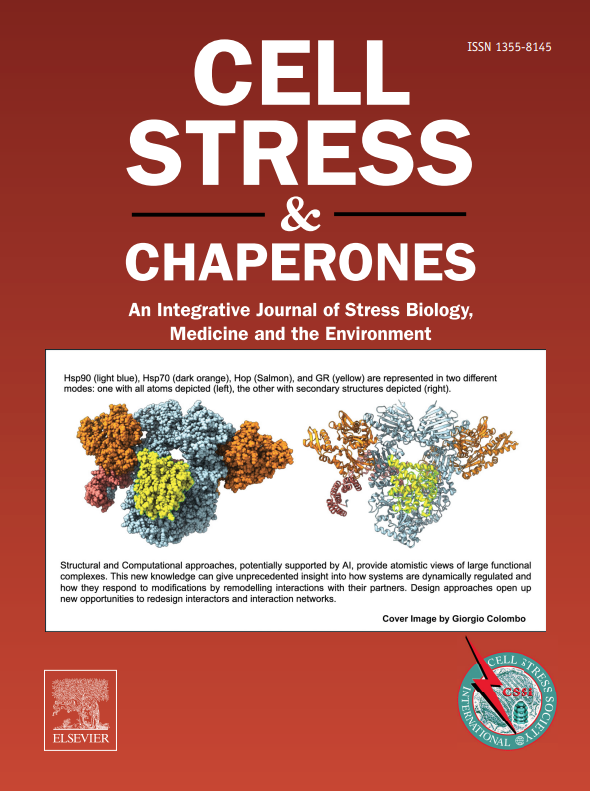FKBP51-Hsp90复合物在阿尔茨海默病中的作用:一个新兴的新药物靶点。
IF 3.2
3区 生物学
Q3 CELL BIOLOGY
引用次数: 0
摘要
随着年龄的增长,蛋白质平衡不可避免地下降,伴侣和共同伴侣的活动变得不平衡。这些变化导致伴侣系统的全局干扰和致病性重新布线,使之成为由蛋白质网络组成的表伴侣体,最终功能失调。蛋白质平衡的这种不平衡可能有利于导致神经系统疾病的机制,如阿尔茨海默病(AD)。因此,在寻找小分子方面的研究活动有所增加,这些小分子可以重新平衡伴侣和共同伴侣机制,以对抗老年引起的疾病的影响。Hsp90的共同伴侣FKBP51最近被确定为一种蛋白质,其诱导不仅随着年龄的增长而增加,而且在AD细胞中进一步升高。值得注意的是,FKBP51在依赖Hsp90的tau异构化中发挥作用,进而影响其磷酸化和对聚集的易感性。我们假设FKBP51是一个主要的参与者,能够引起对淀粉样- β老年斑损伤大脑的反应。我们提出FKBP51水平升高导致FKBP51- hsp90活性异常,从而改变tau的正常加工,表现为tau的过度磷酸化和低聚化。因此,Hsp90-FKBP51复合物正成为治疗AD的药物靶点。为了支持这一观点,最近对FKBP51-Hsp90复合物的结构进行了描述,值得注意的是,小分子二氢吡啶LA1011被证明能够破坏Hsp90-FKBP51复合物。LA1011先前在APPxPS1 AD转基因小鼠模型中被证明能有效预防神经退行性变。本综述着眼于Hsp90及其伴蛋白在AD中的作用,重点关注FKBP51。本文章由计算机程序翻译,如有差异,请以英文原文为准。

The role of the FKBP51–Hsp90 complex in Alzheimer’s disease: An emerging new drug target
With increasing age comes the inevitable decline in proteostasis, where chaperone and co-chaperone activity becomes imbalanced. These changes lead to global disturbances and pathogenic rewiring of the chaperone system into epichaperones consisting of protein networks that are ultimately dysfunctional. Such imbalances in proteostasis may favor mechanisms that can lead to neurological diseases, such as Alzheimer’s disease (AD). Consequently, there has been an increase in research activity toward finding small molecules that can re-balance the chaperone and co-chaperone machinery to counter the effects of disease resulting from old age. The Hsp90 co-chaperone FKBP51 has recently been identified as a protein whose induction not only increases with age but is elevated further in AD cells. Significantly, FKBP51 plays a role in the Hsp90-dependent isomerization of tau, which in turn influences its phosphorylation and susceptibility to aggregation. We hypothesize that FKBP51 is a major player that is able to elicit tauopathy in response to amyloid-beta senile plaques that damage the brain. We propose that elevated FKBP51 levels result in an abnormal FKBP51–Hsp90 activity that alters the normal processing of tau, which manifests as hyperphosphorylation and oligomerization of tau. Thus, the Hsp90–FKBP51 complex is emerging as a drug target against AD. In support of this idea, the structure of the FKBP51–Hsp90 complex was recently described, and significantly, the small-molecule dihydropyridine LA1011 was shown to be able to disrupt the Hsp90–FKBP51 complex. LA1011 was previously shown to effectively prevent neurodegeneration in the APPxPS1 AD transgenic mouse model. This review looks at the role of Hsp90 and its co-chaperones in AD with a focus on FKBP51.
求助全文
通过发布文献求助,成功后即可免费获取论文全文。
去求助
来源期刊

Cell Stress & Chaperones
生物-细胞生物学
CiteScore
7.60
自引率
2.60%
发文量
59
审稿时长
6-12 weeks
期刊介绍:
Cell Stress and Chaperones is an integrative journal that bridges the gap between laboratory model systems and natural populations. The journal captures the eclectic spirit of the cellular stress response field in a single, concentrated source of current information. Major emphasis is placed on the effects of climate change on individual species in the natural environment and their capacity to adapt. This emphasis expands our focus on stress biology and medicine by linking climate change effects to research on cellular stress responses of animals, micro-organisms and plants.
 求助内容:
求助内容: 应助结果提醒方式:
应助结果提醒方式:


